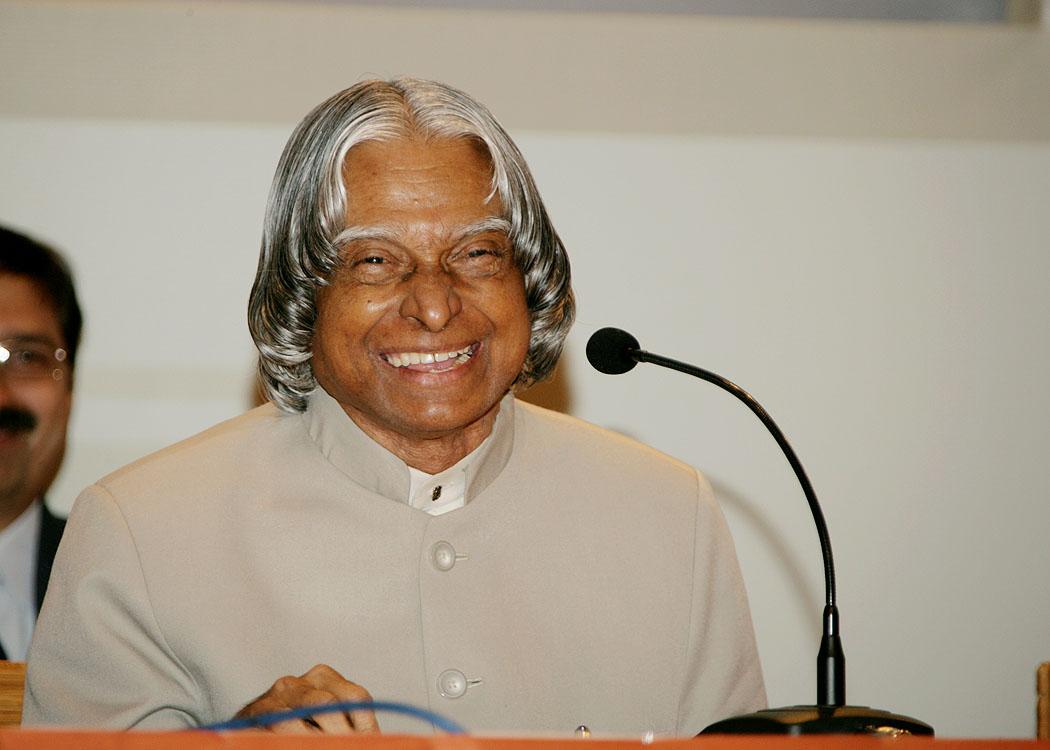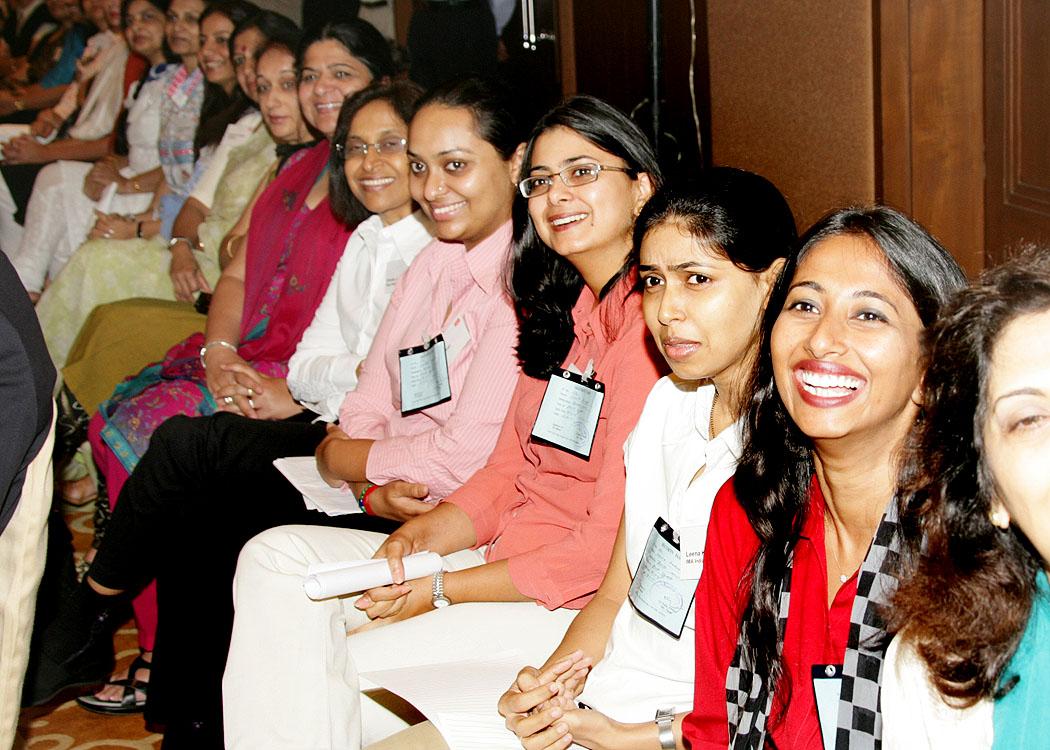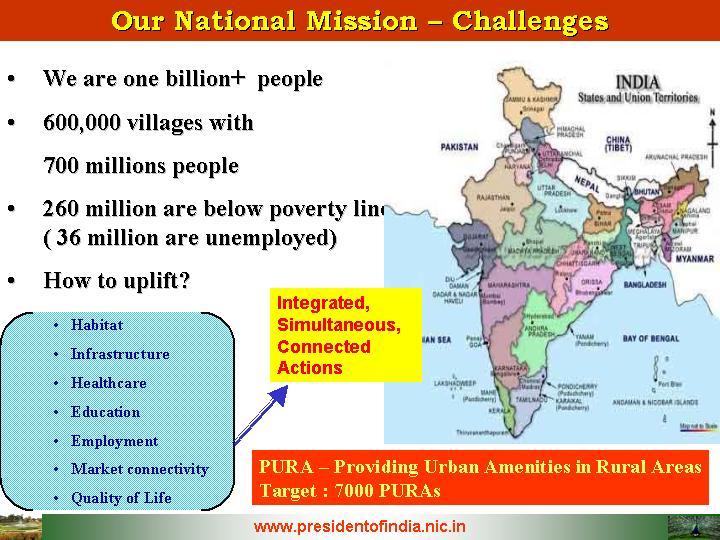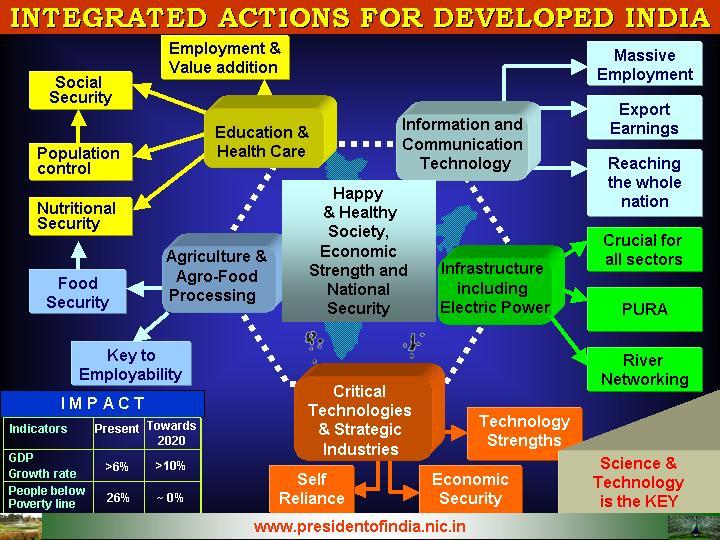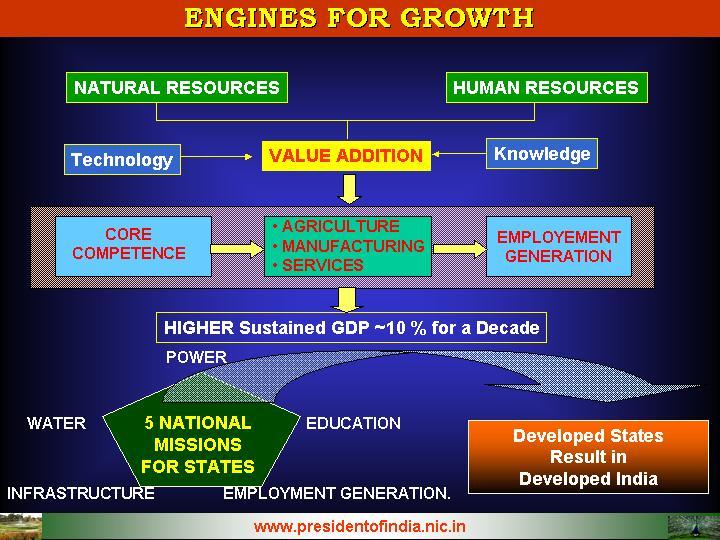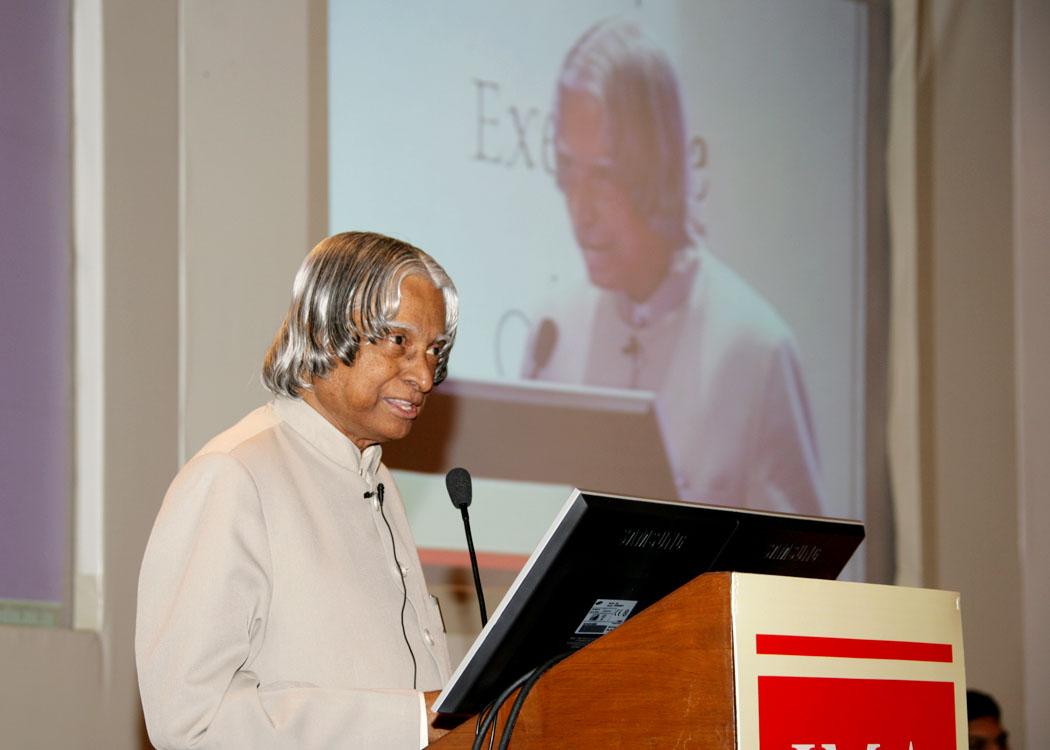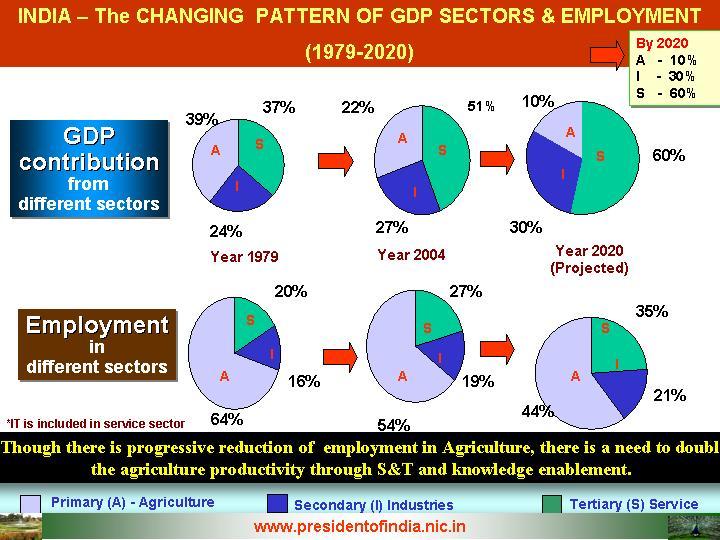Address At The Valedictory Function Of 9Th Annual Chief Executive Officers' Roundtable At Panjim, Goa
Panjim, Goa : 18-10-2005
Dynamics of economic growth in India
I am indeed delighted to be here in this distinguished gathering at the Valedictory function of 9th Annual Chief Executive Officers? Roundtable. I was thinking what thoughts I can share with you. Naturally, you will be interested in the business opportunities, industrial challenges and above all the investment environment. I studied the type of corporates participating in the round table meet, the area of your missions are indeed important for India in the multiple sectors of the economy. Hence, I have selected the topic for the Round table meet, "Dynamics of economic growth in India".
Ambience in the Nation
In the Indian history, very rarely our nation has come across a situation, all at a time, an ascending economic trajectory, continuously rising foreign exchange reserve, reduced rate of inflation, global recognition of the technological competence, energy of 540 million youth, umbilical connectivities of 20 million people of Indian origin in various parts of the planet, and the interest shown by many developed countries to invest in our engineers and scientists including setting up of new R&D centers. Above all India as the largest democracy in the world, has a reputation for its democracy and for providing leadership for the one billion people with multi-cultural, multi-language and multi-religious backgrounds. And also our technological competence and value systems with civilizational heritage are highly respected. Also, FII?s (Federated Investors, Inc) find investing in India attractive. Indians are also investing in abroad and open new business ventures. As per the report titled ?From the Ganges to the Thames? which states that the Indian Foreign Direct Investment in British capital is second only to that of the US and Indian FDI project in Europe has increased from just 5 to 119 during the period 1997 to 2004. The Government is also committed to economic development by ensuring growth rate of 7% to 8% annually, enhancing the welfare of the farmers and workers and unleashing the creativity of the entrepreneurs, business persons, scientists, engineers and other productive forces of the society. Can we expect anything better than this for increasing the momentum of our development missions and economic growth? Let us translate this great opportunity for transforming India to a Developed nation before 2020. This calls for the agriculture, manufacturing and service sectors becoming globally competitive leading to economically competitive. Then a following competitive profile will emerge that will create more opportunities to the corporate sectors working in India.
Profile of a Globally Competitive India
1. A Nation where the rural and urban divide has reduced to a thin line.
2. A Nation where there is an equitable distribution and access to energy and quality water.
3. A Nation where agriculture, industry and service sector work together in symphony, absorbing technology thereby resulting in sustained wealth generation leading to greater high value employment opportunities.
4. A Nation where education is not denied to any meritorious candidates because of societal or economic discrimination.
5. A Nation which is the best destination for the most talented scholars, scientists, and investors from all over the world.
6. A Nation where the best of health care is available to all the billion population and the communicable diseases like AIDS/TB, water and vector borne diseases and other stress diseases, cardiac diseases, cancer and diabetes are brought down.
7. A Nation where the governance uses the best of the technologies to be responsive, transparent, fully connected in a high bandwidth e-governance grid, easily accessible and simple in rules, thereby corruption free.
8. A Nation where poverty has been totally eradicated, illiteracy removed and crimes against women are absent and the society feels unalienated.
9. A Nation that is prosperous, healthy, secure, peaceful and happy and continues with a sustainable growth path.
10. A Nation that is one of the best places to live in, on the earth and brings smiles on a billion plus faces.
It is indeed a big challenge of high magnitude. For achieving such a competitive profile for India, we have a vision of realizing this goal in a time bound manner.
Our National mission - challenges
Our nation is going through a major challenge of uplifting of 260 million people who are below the poverty line and also to give better life for many millions who are on the border line of poverty or just above the poverty line. They need a decent habitat, they need work with reasonable income, they need food, they need speedy access to health care, and they need education and finally they need a good life and hope for a better future. Our GDP is growing at more than 7% per annum on an average. Whereas, the economists suggest that to uplift the people from below the poverty line, our economy has to grow at the rate of 10% per annum consistently, for over a decade.
Integrated action: To meet the need of one billion people, we have the mission of transforming India into a developed nation. We have identified five areas where India has a core competence for integrated action: (1) Agriculture and food processing (2) Reliable and Quality Electric power, Surface transport and Infrastructure for all parts of the country. (3) Education and Healthcare (4) Information and Communication Technology (5) Strategic sectors. These five areas are closely inter-related and if properly implemented, will lead to food, economic and national security of our country.
Engines for Growth: Emphasis should be on full utilization of natural and human resources of the nation to meet the demands of the modern society. We should also remember that about 50% of our population is young people with aspirations for better living. Value addition in Agriculture, Manufacturing and Service sectors, building the national core competence and technologies will lead to additional high income employment potential. The engines for growth will be accelerated by launching of the five national missions viz. water, energy, education and skills, infrastructure and employment generation. The totality of these five missions will enable achievement of 10% GDP growth rate per annum. It is possible to do so with ecological and economic sustainability. It is not the mission of governments. It is a collective efforts of big and small businesses, science and technology and academic institutions, foreign investors, and many others who have confidence about India.
With these aspects in view, we have already laid down the road map. The priority for the government is to convert the road map into various missions. It is to be done in a decentralized manner allowing a greater role for private enterprise and local initiatives. While converting the vision into different missions we seem to have many thoughts and variety of routes to reach the goal. This is where there is a need to have a coherent thinking among all the members of the society, including the legal and law and other agencies. All of us have to think that the nation is greater than an individual or an organization. All of us should believe, that "we can do it". The key question before us is: How to create such an enabling environment?
Changing Pattern of Society
When the world was moving from the industrial to information and knowledge era, we witnessed a changing pattern in the sectoral share of GDP and the number of people employed in each sector. The sectoral share of Gross Domestic Product (GDP) percentage has undergone a considerable change. Contribution of agriculture to India?s GDP has reduced from 39% to 22% during the period 1979 to 2004. During the same period contribution of manufacturing sector has moved from 24% to 27% and whereas the contribution from the services sector has increased from 37% to 51%. There has been considerable change in the employment pattern also. The percentage of people employed in agriculture has come down from 64% to 54%. Simultaneously, the percentage of people employed in manufacturing has gone up from 15% to 19% and in the service sector from 20% to 27%. This trend has to continue and by 2020 our employment pattern should aim at 44% in agriculture, 21% in manufacturing and 35% in service sectors. The displacement of 10% people from agriculture sector has to be facilitated through skill enabling for undertaking value added tasks in the rural enterprises so that migration to urban area is reduced. Instead of the person from the rural areas going to urban towns in search of jobs in manufacturing and services sectors, PURA (Providing Urban Amenities in Rural Areas) facilitates creation of employment in the rural areas itself. PURA achieves this by providing physical, electronic and knowledge connectivities to a cluster of villages thereby leading to their economic connectivity and prosperity. Knowledge creation and knowledge utilisation is the key to the success of a PURA programme. PURA programme generate many business opportunities.
National Missions and opportunities
Let me discuss some of the national missions that India is giving thrust for achieving sustainable economic development for all the regions of the nation. I am sharing these missions with the executives of the corporate industries, so that you may like to participate in developmental process of the nation. First, I would like to discuss about PURA.
Providing Urban Amenities in Rural Areas (PURA)
The number of PURA units for the whole country is estimated to be 7000. This envisages integrated connectivities to bring prosperity to rural India. These are - physical connectivity of the village clusters through quality roads and transport; electronic connectivity through tele-communication with high bandwidth fiber optic cables reaching the rural areas from urban cities and through Internet kiosks; and knowledge connectivity through education, vocational training for farmers, artisans and craftsmen and entrepreneurship programmes. These three connectivities will lead to economic connectivity through starting of enterprises with the help of banks, micro credits and marketing of the products.
Each PURA cluster will connect about 20 villages depending upon the region and population and will cost about Rs.100 crores (~$20 Million). After initial short-term employment during construction etc., we have to plan for initiating actions for providing regular employment and self employment opportunities in nationally competitive small enterprises in agro processing, manufacturing and services sectors for about 3000 people. If the industrial/business parks are marketed well, they can generate employment opportunities in support sector for about 10,000 people in that cluster. This will provide sustainable economy for the rural sector. In this national mission, bankers can promote entrepreneurship in the rural areas. This will lead to the removal of urban-rural divide. This experience can become a model for other countries to follow.
PURA as an Enterprise: A large number of banks have entrepreneurial development programmes. Banks have also been funding Small Scale Industries of different types in various regions. The small scale industrialist is a promising candidate for becoming the chief executive for managing the PURA complexes in an integrated way. PURA enterprises can also undertake management of schools, health care units, vocational training centres, chilling plants, silos and building a market, banking system and the regional business or industrial units. A new mission mode management style has to emerge for PURA enterprises. It should not be looking for protective legislations to support them. Rather they should be efficient to compete with others. This new PURA enterprise needs partnership from the bank, from the Government and also from the private entrepreneurs. Banks can train the entrepreneur for managing the PURA in their training centres and also provide them loans for creating and running PURAs as a business proposition.
Agriculture and agro food processing
As known to all the experts assembled here, India is now producing about 200 million tonnes of food grains, as a result of the first green revolution piloted by the political leadership of Shri. C. Subramaniam, the scientific leadership of Dr. M.S. Swaminathan and willing farmers. India has now embarked on Second Green Revolution which will enable increase in productivity and diversification of the agricultural sector. The second green revolution will have the farmers in focus, farming technology as the friend, food processing and marketing as partners and the consumers as customers. From now on to 2020, India will gradually increase the production to around 400 million tonnes of grains. The increase in the production will have to be done under the reduced availability of land from 170 million hectares to 100 million hectares with reduced water availability. We should also learn to diversify to meet specific consumer preferences, export markets and also in the interest of ecological balance. This is to be achieved through information access to all stakeholders and not with central controls or restriction of movements of agro products.
In addition to this, there is a large potential in medicinal, floriculture and aromatic plants in view of the large bio-diversity potential of India. We have to aim at two billion dollar export potential for all the three areas including orchids which can grow naturally in north east regions of the country.
Our growth focus in the ICT Sector
Now let me discuss about the potential of ICT sector in India. Today the software industry in India is nearly 28 billion dollars ($18 Billion Export and $ 10 Billion Domestic Market) contributing to nearly 24% of nation's exports. This is through IT Services and ITES-BPO Sector, which accounts for around 3.5 % of the global market. India?s core competence is in the area of IT services, IT Enabled Services (ITES) - Business Processing and Outsourcing (BPO). The business volume in these two sectors alone accounts for $850 Billion. India?s first aim is to capture at least 15% of the Global business volume in these two sectors, which is expected to be around 1.2 trillion dollars by 2008. The market share of the Indian Software industry in IT Services, ITES, and BPO alone should be around 200 billion dollars by 2008.
I consider this can be achieved, since our university system is contributing over three million graduates including Engineering graduates every year. This is a vital resource needed for growth in the IT Services, ITES and BPO. Now what is needed is the infrastructural establishment such as IT parks including call centres in large numbers for providing the services which can be established by our IT Companies and the state governments. We should aim at increasing the knowledge pool to 5 million Indian youth by the year 2008, which will enhance the existing efficiency by the factor of 2. Can the ICT Industry captains assembled here meet this challenge? Create BPO, Call Centres and ITES in rural sectors as a part of PURA Enterprises using the Electronic connectivity available in the form high bandwidth broadband connectivity as a dark fiber which has reached till the block level in India. India is planning to establish 2.5 lakh village knowledge centres. ICT industry can establish rural call centres in the model of Kisan Call centre established by the Ministry of Agriculture which can provide domain knowledge in the services, agriculture and manufacturing sectors. This spread will increase the volume of users and automatically bring down the bandwidth cost and create a spiraling effect on efficiency and economy.
Tourism
In spite of all the variety of tourist destinations available, the present tourist arrival in India is 3.7 million. A strategy is getting evolved to increase the tourist arrival to at least 15 million within the next five years and 25 million within the next ten years in partnership with World Travel agencies and tourism specialists.
The corporate sector on tourism present here can study this model and evolve island tourism in Lakshadweep and Andaman & Nicobar. In Lakshadweep, we can also provide hinterland tourist package due to its nearness to Kerala. This will be an additional promotional proposition for our tourism industry. The successful tourism needs quality infrastructure.
Energy Independence
Energy is the lifeline of modern societies. But today, India has 17% of the world?s population, and just 0.8% of the world?s known oil and natural gas resources. We might expand the use of our coal reserves for some time and that too at a cost and with environmental challenges. The climate of the globe as a whole is changing. Our water resources are also diminishing at a faster rate. As it is said, energy and water demand will soon surely be a defining characteristic of our people?s life in the 21st Century.
Energy Security rests on two principles. The first, to use the least amount of energy to provide services and cut down energy losses. The second, to secure access to all sources of energy including coal, oil and gas supplies worldwide, till the end of the fossil fuel era which is fast approaching. Simultaneously we should access technologies to provide a diverse supply of reliable, affordable and environmentally sustainable energy.
As you all know, our annual requirement of oil is 114 million tonnes. Significant part of this is consumed in the Transportation Sector. We produce only about 25 % of our total requirement. The presently known resources and future exploration of oil and gas may give mixed results. The import cost today of oil and natural gas is over Rs. 120,000 crores. Oil and gas prices are escalating; the barrel cost of oil has doubled within a year. This situation has to be combated.
Energy Security, which means ensuring that our country can supply lifeline energy to all its citizens, at affordable costs at all times, is thus a very important and significant need and is an essential step forward. But it must be considered as a transition strategy, to enable us to achieve our real goal that is - Energy Independence or an economy which will function well with total freedom from oil, gas or coal imports. Is it possible?
Hence, Energy Independence has to be our nation?s first and highest priority. We must be determined to achieve this within the next 25 years i.e by the year 2030. This one major, 25-year national mission must be formulated, funds guaranteed, and the leadership entrusted without delay as public-private partnerships to our younger generation, now in their 30?s, as their lifetime mission in a renewed drive for nation-building.
The corporate sector assembled here has to participate in a big way in alternative energy programmes and banking sector should financially support these programmes in a big way. Now I would like to discuss on Bio-fuel and power generation missions.
A. Bio-fuel Mission:
Government has decided to permit of mixing of 10% bio-fuel with diesel. This has opened up new opportunities for employment and wealth generation. We have nearly 63 million hectares of wasteland available in the country, out of which 33 million hectares of wasteland have been allotted for tree plantation. Certain multi-purpose trees such as Jatropha can grow well in wasteland with very little input. Once grown the crop has a fifty years of life. Fruiting can take place in this plant in less than two years.
It yields oil seeds up to five tonnes per hectare per year and produces two tonnes of bio-diesel. Presently, the cost of bio-diesel through the plant is approximately Rs. 17 to Rs. 19 per litre which can be substantially reduced through choice of right size of the plant and using high yield variety plantation. Bio-diesel plants grown in 11 million hectares of land can yield a revenue of approximately Rs. 20,000 crore (nearly four billion) a year and provide employment to over 12 million people both for plantation and running of the extraction plants. This is a sustainable development process leading to large scale employment of rural manpower. Also, it will reduce the foreign exchange outflow paid for importing crude oil, the cost of which is continuously rising in the international market. Moreover, use of Bio-fuel is CO2 emission free. This oil can also be used for soap and candle industries. De-oiled cake is a raw material for composting. Also Jatropha plantation provides a good environment for honey production. We should absorb best of the technologies available worldwide and start commercial operation soon. I would request the banking community assembled here to take the initiative, generate detailed project report in collaboration with technical agencies on this project and promote entrepreneurs with financial support from the banks in rural areas who can undertake the plantation and commissioning of extraction plant leading to production of cost-effective bio-fuel. Can there be a better project than this for coherent development of our rural sector?
B. Power mission:
Currently, India?s power generating capacity is 100,000 mega watts of power. For meeting the development targets till 2020 our generating capacity has to increase to 300,000 mega watts. This additional power has to come from nuclear energy(20,000MW), hydroelectric systems(84,000MW), renewable energy(100,000MW) and thermal energy(96,000MW). The contribution from the renewable energy especially from solar energy and wind energy has to be increased to one hundred thousand mega watts. Urgent measures are needed to reduce the distribution loss to less than 5% from the existing 25%.
The country is to think in terms of sustainable clean power. India has abundant solar energy, thorium raw material and water resources. Let me now discuss about how we can harness these energy sources.
Solar farms: Solar energy in particular requires unique, massive applications in the agricultural sector, where farmers need electricity exclusively in the daytime. This could be the primary demand driver for solar energy. Our farmers demand for electric power today is significantly high to make solar energy economical in large scale.
Shortages of water, both for drinking and farming operations, can be met by large scale seawater desalination and pumping inland using solar energy, supplemented by bio-fuels wherever necessary.
The current high capital costs of solar power stations can be reduced by grid-locked 100 MW sized Very Large Scale Solar Photovoltaic (VLSPV) or Solar Thermal Power Stations. In the very near future, breakthroughs in nanotechnologies promise significant increase in solar cell efficiencies from current 15% values to over 50% levels. These would in turn reduce the cost of solar energy production. Our science laboratories should mount a R&D Programme for developing high efficiency CNT based Photo Voltaic Cells.
We thus need to embark on a major national programme in solar energy systems and technologies, for both large, centralized applications as well as small, decentralized requirements concurrently, for applications in both rural and urban areas.
Nuclear Energy: Nuclear power generation has been given a thrust by the use of uranium based fuel. However there would be a requirement for a ten fold increase in nuclear power generation even to attain a reasonable degree of energy self sufficiency for our country. Therefore it is essential to pursue the development of nuclear power using Thorium, reserves of which are higher in the country. Technology development has to be accelerated for Thorium based reactors since the raw material for Thorium is abundantly available in our country. Also, Nuclear Fusion research needs to be progressed with international cooperation to keep that option for meeting the large power requirement, at a time when fossil fuels get depleted.
Hydro Power Generation: A typical hydro resource availability, which I would like to discuss with you as an example for the hydro power generation. Recently when I visited, Sikkim, I found that the innumerable streams and rivers flowing down the Himalayas provide Sikkim the potential of generating approximately 8000 MW of electric power through hydro electric process. I notice that work is progressing on hydel projects having installed capacity of over 700 MWs including one large hydel project with 510 MW capacity with financial support from state government, MNES and other agencies. In addition there are 21 schemes allotted to different private sector agencies and are in DPR or investigation stages. These schemes have a potential to generate over 4000 MWs of power. I have suggested that the Sikkim Government can take up these projects on mission mode, so that by 2010 all the additional 5000 MWs of power become available to the state. This additional power will cater to the industrial and agricultural needs of the State and assist Sikkim in increasing the pace of development. The surplus power can be marketed to the main grid and can become a wealth generator for Sikkim.
Similarly, if we link the rivers across the nation, we will be able to generate over 65,000 Mega watts of hydel power. Public private partnership is required for this mission. The corporate sector can play a very important role in achieving this mission. This will pave the way for higher industrial growth.
Apart from these missions, I would like to highlight how to make the environment clean and convert the municipal waste to generate the power.
Bankers - a partner to developmental mission
Banking sector has a tremendous role in reinforcing the economy of the nation, by servicing the micro economic needs of all the three sectors of the economy ? agriculture, manufacturing and services, at the centres of action in the country.
The financial services industry has been in the vanguard in the development phase in all the countries. The proactive approach adopted by many banks has led to phenomenal growth of the country. The days of development financial institutions seem to be over. The current fashion is the Universal Bank. The development finance responsibility with its inherent risks is squarely and fully on the banking sector. It is in this background I wish the bankers to play a positive role to assist the country to march towards development faster.
In India we have the experience of providing venture capital to a number of entrepreneurs. Of course few of them succeeded also. In the present economic situation, it is essential the venture capital business for mission mode projects has to increase in magnitude, particularly with hassle free procedures. This will accelerate the growth cycle and competitiveness of products in the world market.
Now let me discuss on how to carry out these missions with the human resource potential that India has and that is our core competence.
Global Human Resources Cadre
In the 21st century, India needs a large number of talented youth with higher education for the task of knowledge acquisition, knowledge imparting, knowledge creation and knowledge sharing. I am working for it. At present India has five hundred and forty million youth under the age of 25 which will continuously be growing till the year 2050. Keeping this resource in mind, the Universities and educational systems should create two cadres of personnel: (1) a global cadre of skilled youth with specific knowledge of special skills (2) another global cadre of youth with higher education. These two cadres will be required not only for powering the manufacturing and services sector of India but also will be needed for fulfilling the human resource requirements of various countries. Thus, the universities will have to work towards increasing the throughput of the higher education system from the existing 6% to 20% by the year 2015, 30% by the year 2020 and 50% by the year 2040. The rest of the youth who are not covered by the higher education system should have skill sets in areas such as construction, carpentry, electrical systems, repair of mechanical systems, fashion design, para-legal, para-medical, accountancy, sales and marketing, software and hardware maintenance and service, software quality assurance personals etc. This is the mission which must be undertaken by the corporate sector in partnership with educational institutions.
Conclusion
As you all come from industry, banking and other corporate institutions, I would like to talk to you about the linkage between the national economic development and creative leadership:
- Nation?s Economic development is powered by competitiveness.
- The competitiveness is powered by knowledge power.
- The knowledge power is powered by Technology and innovation.
- The Technology and innovation is powered by resource investment.
- The Resource investment is powered by revenue and return on Investment.
- The Revenue is powered by Volume and repeat sales through customer loyalty.
- The customer loyalty is powered by Quality and value of products. - Quality and value of products is powered by Employee Productivity and innovation.
- The Employee Productivity is powered by Employee Loyalty, employee satisfaction and working environment.
- The Working Environment is powered by management stewardship and sound project management.
- Management stewardship is powered by Creative leadership.
For success in all the missions which we have discussed so far, we need creative leaders. Creative leadership means exercising the vision to change the traditional role from the commander to the coach, manager to mentor, from director to delegator and from one who demands respect to one who facilitates self-respect. I am sure creative leadership spearheads all the institutions and the future aspiring institutions. For a prosperous and developed India, the important thrust will be on the growth in the number of creative leaders and innovative organisations that can create wealth through dedicated management system. In addition, if the CEO?s and banking sector can work out a plan for new type of venture capital to generate new enterprises.
My best wishes to all the participants of this CEO?s round table success in the mission of win-win partnership of the corporate with the Government leading to the economic prosperity of India.
May God bless you!
When I was involved through TIFAC for the major Vision 2020 studies in 17 centers during 1994-95, which included business leaders, economists, etc there were a number of skeptics - many felt that India cannot assume 7 to 8% growth rate. Even in 1998, when the book India 2020 was published there were still doubters about India?s future - even management gurus and CEOs.
Now India's growth rate is being discussed when it will get into 10% region? I therefore request you to take away the spectacle of skepticism for a while and look at the beautiful future of India before you - 7 to 10 years from now. Once you see that with your great managerial expert you will chalk out a road map how to reach there and also the schedules to monitor and criteria for mid course corrections. With this in view I am asking five questions.
Q1. How to spread penetration of economic growth to all parts of India, to every district in such a way that people of India see a change in their lives every year?
Q2. How to transform the human resource cadre in India into a great wealth? Wealth in their hands, wealth for business houses? And national wealth? I would like to see (a) Transformation of the capabilities of those who are 50 years and below, whether they are currently working or not including women and (b) the young children who are in the pipeline (in schools, colleges and as drop outs) turned into world class knowledge and skilled engines?
Q3. India generates many MNCs whose presence will be felt in all the continents ? for enterprise, quality, competitiveness and value systems ? do you think it is possible, how many ? what time frame?
Q4. Global giants in high technology business have large R&D centers in India and generate about 20% of IPRs from their R&D centers located in India. Is this a feasible target? When can it happen? What should we do to accelerate the process?
Q5. While all , the four questions were hardcore business type questions in which field you are masters, the last one is about providing healthcare access to all Indians (I mean the one billion plus) -day to day medications, periodic check up for preventive diagnostic to major treatment, do you foresee such a possibility with universal access and affordable rates say by 2050 ? Can you come up with a plan of action in about two months? I would like to mention the reported cost of ill-health due to heart disease, stroke and diabetes by 2015 will be around $235 billion for India.
I would request some quick answers during the meeting today for all the five questions and detailed report to me with in one month. Is it too much of intrusion of the time of busy CEO's?

